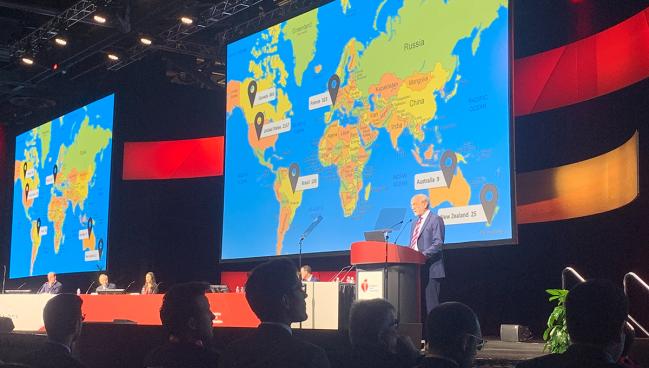MINT Hints at Benefits of Liberal Transfusions in Acute MI With Anemia
(UPDATED) The primary endpoint was missed in MINT, but most study findings suggest a restrictive transfusion strategy has little to add.

PHILADELPHIA, PA—Liberal use of red blood cell transfusions is not superior to a more restrictive approach in patients with acute MI and anemia, but results from the MINT trial suggest that it may be associated with lower rates of some outcomes, including cardiac death.
“In contrast to other clinical settings, the trial results suggest that a liberal transfusion strategy has the potential for clinical benefit with low risk, and the liberal transfusion strategy may be the most prudent approach to transfusion in anemic patients with myocardial infarction,” lead study author Jeffrey Carson, MD (Rutgers Biomedical Health Sciences, New Brunswick, NJ), said in a press conference. Carson presented the results in a late-breaking science session today at the American Heart Association (AHA) 2023 Scientific Sessions. The study was simultaneously published in the New England Journal of Medicine.
On the one hand, transfusions could decrease the risk of ischemic injury by boosting the delivery of oxygen to myocardial tissues, as well as limit the risk of reinfarction or death. There are downsides to giving them, however, which include an increased risk of heart failure due to fluid overload, infection from immunosuppression, thrombosis from higher viscosity, and inflammation, Carson and colleagues note.
A prior study, REALITY, showed that limiting transfusions to those with hemoglobin (Hb) levels of 8 g/dL or lower was noninferior to higher transfusion cutoffs at preventing MACE at 30 days. Prior to that trial, there had been only a few small studies, which had yielded conflicting results about how to handle indications for transfusion in this population of patients, Carson and colleagues say.
“The MINT trial really addresses a question that is very common to all of us,” noted Martin Leon, MD (NewYork-Presbyterian/Columbia University Irving Medical Center, New York, NY), who served as a discussant in the AHA media briefing. “As we attend on a coronary care unit, we see many patients that have anemia and myocardial infarction, and we don't have a good answer to the question as to who should receive transfusional therapy.”
Leon added that despite MINT showing a statistically nonsignificant difference between the restrictive and liberal transfusion groups for the composite of MI or death at 30 days, “so many of the things are in favor of a more liberal transfusional therapy that I think that will likely be the general interpretation.”
Most striking, he said, is the finding of a higher rate of cardiac death in the restrictive group, at 5.2% versus 3.2% for the liberal group (RR 1.74; 95% CI 1.26-2.40).
Some Hints of Benefit
MINT included 3,504 acute MI patients (mean age 72.1 years; 45.5% women; 12.6% Black) from 144 sites in the United States, Canada, France, Brazil, New Zealand, and Australia. All had a hemoglobin level of less than 10 g/dL and were randomized to a restrictive (7-8 g/dL Hb cutoff) or liberal transfusion strategy (< 10 g/dL Hb cutoff). Prior to randomization, the mean Hb level was 8.6 g/dL.
In the restrictive group, transfusion was permitted, but not required, at < 8 g/dL, and it was strongly recommended at < 7 g/dL or when anginal symptoms were not controlled with medications. Patients in the liberal group received one transfusion after randomization, with additional transfusions as needed to maintain a Hb of 10 mg/dL until discharge or 30 days. For those in the restrictive group who received transfusions, Carson told TCTMD that the protocol was “to get them above 8 g/dL,” at which point they would not receive any additional transfusions unless they dropped below that level.
The index MI was NSTEMI in more than 80% and 56% of patients had type 2 MI. One-third of patients had a history of PCI, 32.5% had prior MI, 21.7% had prior CABG, and 30.4% had heart failure (HF).
The rate of the primary outcome (a composite of MI or death at 30 days) was 16.9% in the restrictive group and 14.5% in the liberal group (RR 1.15; 95% CI 0.99-1.34), just missing statistical significance. By individual component of the primary outcome, MI occurred in 8.5% and 7.2%, respectively (RR 1.19; 95% CI 0.94-1.49) and death in 9.9% and in 8.3%, respectively (RR 1.19; 95% CI 0.96-1.47).
Additionally, the composite outcome of death, MI, ischemia-driven unscheduled coronary revascularization, or readmission for an ischemic cardiac condition within 30 days occurred in 19.6% of the restrictive group and 17.4% of the liberal group (RR 1.13; 95% CI 0.98-1.29).
HF at 30 days was not different between the groups, but the restrictive group had fewer transfusion-associated cardiac overload (TACO) events than the liberal group (0.5% vs 1.3%; RR 0.35; 95% CI 0.16-0.78). However, frequency of HF, which Carson and colleagues say is a more comprehensive measure of volume overload than TACO, was similar between groups, as were other safety outcomes.
In prespecified subgroup analyses, the only difference was seen in patients with type 1 MI, in whom more primary outcome events were seen with a restrictive versus liberal transfusion strategy (RR 1.32; 95% CI 1.04-1.67). The association was not seen in those with type 2 MI.
Reflecting Real-world Decisions
Carson and colleagues say the findings are generalizable to real-world populations with acute MI and anemia for several reasons, including the “wide variety of older patients who had a variety of myocardial infarction diagnoses, including both ST-segment elevation and non-ST-segment elevation and both type 1 and type 2 myocardial infarctions.”
Speaking in the press conference, Leon agreed, noting that very few patients were excluded. He pointed out, however, that nearly 90% of participants were from the United States or Canada, making the generalizability somewhat limited.
MINT differs from REALITY in that the Hb cutoff for triggering transfusion discussion in the restrictive group was lower than 8 g/dL. To TCTMD, Carson said that was done to provide more flexibility.
“Many clinicians were using a [7 g/dL] threshold because that's been established in critical care patients, and therefore we wanted to make it pragmatic and associated with what clinicians do,” he said.
“We haven't at this point looked at the outcomes between those who were transfused at 7 versus 8, but it was a very pragmatic decision of getting clinicians to be willing to enroll their patients.”
As noted by discussant C. Michael Gibson, MD (Beth Israel Deaconess Medical Center, Boston, MA), it’s unclear whether anemia is a marker of comorbidity and whether it should be targeted for intervention. In trauma patients, as well as after acute MI PCI and CABG, transfusion has been associated with higher risk for mortality. Other risks of transfusion may be related to reduced quality from prolonged storage and other complications like graft-versus-host disease (GVHD).
While the MINT trial has limitations including being underpowered, it is four times larger than REALITY and the other studies in this area put together, Gibson noted.
“Given the lack of harm associated with liberal transfusion and given the preponderance of data, I think this trial favors liberal transfusion in the largest trial to date,” Gibson said. “I think this is a viable management strategy, particularly in those people with non-STEMIs, type 1 MIs, and as your clinical judgment dictates.”
Following his presentation, Carson listed another factor for physicians to consider when weighing transfusion decisions—namely that there appears to be no harm.
“We're not really seeing much in the way of downside there, and for that reason, I think that strengthens the argument,” he added.
Panelist Connie N. Hess, MD (University of Colorado School of Medicine, Aurora), agreed, saying she believes the MINT data are “reassuring.”
Co-moderator Roxana Mehran, MD (Icahn School of Medicine at Mount Sinai, New York, NY), however, had one caveat: she wanted “to make sure that people don't walk away with the idea that they should be liberally transfusing everyone with an MI.” Ideally, given the shortage in blood donations, she’d love to know which patients might benefit most.
“The question really is, do we have enough blood to use [liberally] in this setting?” Carson said. While generally not a problem in the United States, this could be an issue in other countries or during unusual times such as the COVID-19 pandemic, he conceded.
L.A. McKeown is a Senior Medical Journalist for TCTMD, the Section Editor of CV Team Forum, and Senior Medical…
Read Full BioSources
Carson JL, Brooks MM, Hébert PC, et al. Restrictive or liberal transfusion strategy in myocardial infarction and anemia. N Engl J Med. 2023;Epub ahead of print.
Disclosures
- Carson reports no relevant conflicts of interest.





Comments